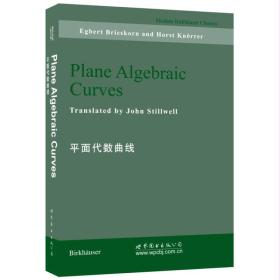
平面代数曲线
正版新书 新华官方库房直发 可开电子发票
¥ 51.94 5.3折 ¥ 98 全新
库存8件
江苏无锡
认证卖家担保交易快速发货售后保障
作者Egbert、Horst Knorrer 著
出版社世界图书出版公司
出版时间2016-01
版次1
装帧平装
货号文轩11.12
上书时间2024-11-12
- 在售商品 暂无
- 平均发货时间 14小时
- 好评率 暂无
- 店主推荐
- 最新上架
商品详情
- 品相描述:全新
图书标准信息
- 作者 Egbert、Horst Knorrer 著
- 出版社 世界图书出版公司
- 出版时间 2016-01
- 版次 1
- ISBN 9787510097966
- 定价 98.00元
- 装帧 平装
- 开本 16开
- 纸张 胶版纸
- 【内容简介】
-
作者在详细全面地介绍了平面代数理论,并从两方面分析了这个数学的经典研究领域:其在古希腊数学研究中的显著地位;它依然是当代数学研究领域里的灵感激发者和主题。同时该书也为我们综合理解和研究当代关于奇异性的研究打下了基础。第一章中展示了许多拥有优美几何体的特殊曲线——丰富的插图是该书的一大特点,还介绍了投影几何学(在复数域上)。第二章中对Bezout定理进行了简单的证明并详细论述了三次曲线。
- 【作者简介】
-
Egbert Brieskorn和Horst Knorrer,是国际知名学者,在数学界享有盛誉。本书凝聚了作者多年科研和教学成果,适用于科研工作者、高校教师和研究生。
- 【目录】
-
Ⅰ History of algebraic curves
1. Origin and generation of curves
1.1 The circle and the straight line
1.2 The classical problems of antiquity
1.3 The conic sections
1.4 The cissoid of Diocles
1.5 The conchoid of Nicomedes
1.6 The spiric sections of Perseus
1.7 From the epicycles of Hipparchos to the Wankel motor
1.8 Caustics and contour curves in optics and perspective
1.9 Further examples of curves from science and technology
2. Synthetic and analytic geometry
2.1 Coordinates
2.2 The development of analytic geometry
2.3 Equations for curves
2.4 Examples of the application of analytic methods
2.5 Newton‘s investigation of cubic curves
3. The development of projective geometry
3.1 Descriptive geometry and projective geometry
3.2 The development of analytic projective geometry
3.3 The projective plane as a manifold
3.4 Complex projective geometry
Ⅱ Investigation of curves by elementary algebraic methods
4. Polynomials
4.1 Decomposition into prime factors
4.2 Divisibility properties of polynomials
4.3 Zeroes of polynomials
4.4 Homogeneous and inhomogeneous polynomials
5. Definition and elementary properties of plane algebraic curves
5.1 Decomposition into irreducible components
5.2 Intersection of a curve by a line
5.3 Singular points of plane curves
6. The intersection of plane curves
6.1 Bezout‘s theorem
6.2 Applications of Bezout‘s theorem
6.3 The intersection ring of P2(c)
7. Some simple types of curves
7.1 Quadrics.
7.2 Linear systems of cubics
7.3 Inflection point figures and normal forms of cubics
7.4 Cubics, elliptic curves and abelian varieties
Ⅲ Investigation of curves by resolution of singularities
8. Local investigations
8.1 Localisation-local rings
8.2 Singularities as analytic set germs
8.3 Newton polygons and Puiseux expansions
8.4 Resolution of singularities by quadratic transformations
8.5 Topology of singularities
9. Global investigations
9.1 The Plucker formulae
9.2 The formulae of Clebsch and Noether
9.3 Differential forms on Riemann surfaces and their periods
Bibliography
Index
内容摘要
作者在详细全面地介绍了平面代数理论,并从两方面分析了这个数学的经典研究领域:其在古希腊数学研究中的显著地位;它依然是当代数学研究领域里的灵感激发者和主题。同时该书也为我们综合理解和研究当代关于奇异性的研究打下了基础。章中展示了许多拥有优美几何体的特殊曲线——丰富的插图是该书的一大特点,还介绍了投影几何学(在复数域上)。第二章中对Bezout定理进行了简单的证明并详细论述了三次曲线。
主编推荐
Egbert Brieskorn和Horst Knorrer是国际知名学者,在数学界享有盛誉。本书凝聚了作者多年科研和教学成果,适用于科研工作者、高校教师和研究生。
点击展开
点击收起
相关推荐
— 没有更多了 —



























以下为对购买帮助不大的评价